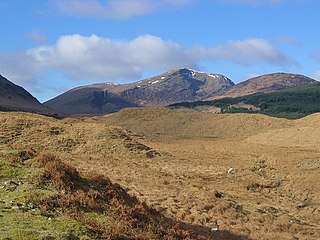Bibliography
- Neville, Cynthia J., Native Lordship in Medieval Scotland: The Earldoms of Strathearn and Lennox, c. 1140-1365, (Portland & Dublin, 2005)
Mormaer Maol Choluim I of Lennox (English: Malcolm I) ruled the Mormaerdom of Lennox, between 1250 and 1303, succeeding his father Maol Domhnaich.
He was an early supporter of the Bruces, and appeared before Edward I of England in 1292 amongst the supporters of Robert Bruce, 5th Lord of Annandale. Maol Choluim joined the revolt of Andrew de Moray and William Wallace.
Maol Choluim married a woman named Marjorie, and fathered his successor Maol Choluim II
He died in 1303.
Year 1333 (MCCCXXXIII) was a common year starting on Friday of the Julian calendar.

The wars of Scottish Independence were a series of military campaigns fought between the Kingdom of Scotland and the Kingdom of England in the late 13th and early 14th centuries.

Lord Napier, of Merchistoun, is a title in the Peerage of Scotland. It was created in 1627 for Sir Archibald Napier, 1st Baronet. Earlier that year, he already held the Napier Baronetcy, of Merchistoun in the County of Midlothian, created in the Baronetage of Nova Scotia. The titles remained united until 1683, when the Baronetcy became dormant. It was revived in the early 19th century and is now held by another branch of the Napier family. Between 1683 and 1686, the Lords of Napier also held the Nicolson Baronetcy, of Carnock in the County of Stirling, and since 1725 the Scott Baronetcy, of Thirlestane in the County of Selkirk, both baronetcies created in the Baronetage of Nova Scotia. The latter is still held today. Additionally, the tenth Lord was created Baron Ettrick, of Ettrick in the County of Selkirk in the Peerage of the United Kingdom on 16 July 1872.
The Earl of Fife or Mormaer of Fife was the ruler of the province of Fife in medieval Scotland, which encompassed the modern counties of Fife and Kinross. Due to their royal ancestry, the earls of Fife were the highest ranking nobles in the realm, and had the right to crown the king of Scots.
Malcolm, Malcom, Máel Coluim, or Maol Choluim may refer to:
Mormaer Maol Domhnaich was the son of Mormaer Ailín II, and ruled Lennox 1217–1250.

Mormaer Maol Choluim II of Lennox was mormaer of Lennox from 1303 to his death.

Malise IV of Strathearn was a Scottish nobleman, the seventh known ruler of Strathearn. He was an ardent supporter of King Robert the Bruce, in contrast to his father, Malise III, who sided with Edward I of England.
Mormaer Domhnall of Lennox ruled Lennox in the years 1333–1365. He succeeded his father Maol Choluim II.

Domhnall I, Earl of Mar, also known by the name Domhnall mac Uilleim, was the seventh known mormaer of Mar in medieval Scotland, ruling from the death of his father, Uilleam of Mar, in 1276 until his own death sometime between 1297 and 1302. If Gille Críst is excluded, Domhnall I is considered the sixth mormaer or Earl of Mar.
Cailean Mór Caimbeul is one of the earliest attested members of Clan Campbell and an important ancestor figure of the later medieval Earls of Argyll.

The Battle of Dalrigh, also known as the Battle of Dail Righ, Battle of Dalry or Battle of Strathfillan, was fought in 1306 between the army of King Robert the Bruce against Clan MacDougall of Argyll, who were allies of Clan Comyn and the English. It took place at the hamlet of Dalrigh near Tyndrum in Perthshire, Scotland. Bruce's army, reeling westwards after defeat by the English on 19 June at the Battle of Methven, was intercepted and all but destroyed, with Bruce himself narrowly escaping capture. The battle took place sometime between July and early August, but the exact date is unknown.
Maol Choluim de Innerpeffray was a 14th-century bishop-elect of Dunkeld. He was a canon from Strathearn. After the death of bishop William Sinclair, the canons of Dunkeld held an election, which was held late in the year 1337 or early 1338. The result was disputed. Maol Choluim's election was challenged by Richard de Pilmor.
The Prior of Oronsay was the Religious Superior of Oronsay Priory, a community of canons regular on the island of Oronsay, Inner Hebrides, off the coast of Scotland. It was in existence by 1353, perhaps founded by John of Islay, Lord of the Isles.
Archibald of Douglas was a Scottish nobleman. He was the son of William of Douglas.
Gofraid mac Domnaill, was a thirteenth-century Scottish rebel. The son of Domnall, his father's surname was almost certainly MacWilliam though Bane has been proposed.
Malcolm II was King of the Scots from 1005 to 1034.
Events from the year 1333 in the Kingdom of Scotland.
Maol may refer to:
Events from the 1210s in the Kingdom of Scotland.